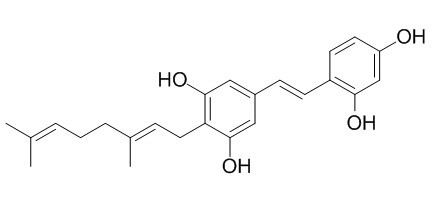Chlorophorin
Chlorophorin shows high anti-protozoal activity with an MIC of 0.25 microg/ml. Chlorophorin can strongly inhibit mushroom tyrosinase activity with IC50 values of 2.5 ± 0.408 uM; it inhibits α-melanocyte-stimulating hormone-induced melanin production in B16F10 melanoma cells.
Inquire / Order:
manager@chemfaces.com
Technical Inquiries:
service@chemfaces.com
Tel:
+86-27-84237783
Fax:
+86-27-84254680
Address:
1 Building, No. 83, CheCheng Rd., Wuhan Economic and Technological Development Zone, Wuhan, Hubei 430056, PRC
Providing storage is as stated on the product vial and the vial is kept tightly sealed, the product can be stored for up to
24 months(2-8C).
Wherever possible, you should prepare and use solutions on the same day. However, if you need to make up stock solutions in advance, we recommend that you store the solution as aliquots in tightly sealed vials at -20C. Generally, these will be useable for up to two weeks. Before use, and prior to opening the vial we recommend that you allow your product to equilibrate to room temperature for at least 1 hour.
Need more advice on solubility, usage and handling? Please email to: service@chemfaces.com
The packaging of the product may have turned upside down during transportation, resulting in the natural compounds adhering to the neck or cap of the vial. take the vial out of its packaging and gently shake to let the compounds fall to the bottom of the vial. for liquid products, centrifuge at 200-500 RPM to gather the liquid at the bottom of the vial. try to avoid loss or contamination during handling.
Journal of Functional Foods2023, 104:105542
Food Bioscience2022, 50:102187.
Jeju National University Graduate School2023, 24478
Nutrients.2020, 12(12):3607.
Mol Pharm.2017, 14(9):3164-3177
J Plant Biotechnol.2023, 50:070-075.
The Journal of Phytopharmacology2020, 9(1): 1-4
Microchemical Journal2024, 200:110475
Heliyon.2023, 9(11):e21944.
Chinese Journal of Tissue Engineering Research2024, 28(8):1149-1154.
Related and Featured Products
Planta Med 2014; 80 - P2O73
The inhibitory effect of chemical constituents derived from Artocarpus xanthocarpus on melanin biosynthesis[Reference:
WebLink]
METHODS AND RESULTS:
Eighteen known compounds and six new compounds were isolated from the roots of Artocarpus xanthocarpus, and their structures were spectroscopically determined. The new compounds included artoxanthocarpuone A (1), artoxanthocarpuone B (2), hydroxylakoochin A (3), methoxylakoochin A (4), epoxylakoochin A (5), and artoxanthol (6). Among the isolated compounds, artoxanthol (6), arboctalol (9) steppogenin (11), norartocarpetin (12), resveratrol (19), oxyresveratrol (20), and Chlorophorin (21) strongly inhibited mushroom tyrosinase activity with IC50 values of 5.7 ± 0.3, 6.4 ± 0.3, 1.9 ± 0.1, 0.9 ± 0.1, 4.9 ± 0.3, 1.0 ± 0.5, and 2.5 ± 0.4μM, respectively.
CONCLUSIONS:
Artoxanthocarpuone A (1), artoxanthocarpuone B (2), methoxylakoochin A (4), lakoochin A (8), cudraflavone C (17), artonin A (18), resveratrol (19), and Chlorophorin (21) reduced tyrosinase activity and inhibited α-melanocyte-stimulating hormone-induced melanin production in B16F10 melanoma cells and were not cytotoxic. Collectively, our results suggest the potential utility of A. xanthocarpus-derived compounds as depigmenting agents.
J Ethnopharmacol. 2001 Nov;78(1):59-66.
Anti-amoebic activity of plant compounds from Virgilia oroboides and Chlorophora excelsa.[Pubmed:
11585689]
The anti-amoebic activity of four plant extracts: maackiain and formononetin from Virgilia oroboides and Chlorophorin and Iroko from Chlorophora excelsa, were evaluated.
METHODS AND RESULTS:
Anti-protozoal tests conducted on trophozoites of Entamoeba histolytica established that all four compounds had an affect on the trophozoites to some degree. Chlorophorin showed the highest anti-protozoal activity with an MIC of 0.25 microg/ml followed by maackiain and Iroko with MICs of 1 microg/ml. Chlorophorin and Iroko induced the release of acid phosphatase. Chlorophorin reduced alpha amylase levels by 89%. Formononetin and maackiain had a minimal effect on the enzyme levels. Ultrastructural changes occurred in trophozoites treated with plant compounds. The degree of destruction of the trophozoites increased with an increase in compound concentration. Trophozoite destruction was initiated by the disintegration of the nucleus and culminated with the rupture of the cytoplasmic membrane.
CONCLUSIONS:
Maackiain was the only compound that showed some level of mutagenicity. Formononetin and Iroko were very slightly mutagenic, while Chlorophorin was non-mutagenic. In addition, none of the compounds tested showed cytopathic effects on any of the cell lines tested. Chlorophorin and Iroko exhibit the potential to be exploited as natural multi-functional safe control agents in the treatment of bacterial, fungal and protozoal infections.
Planta Med. 1998 Jun;64(5):408-12.
The inhibitory components from Artocarpus incisus on melanin biosynthesis.[Pubmed:
9690341 ]
The inhibitory effects of methanol extracts of heartwood of 23 Papua New Guinean wood species on tyrosinase activity were examined.
METHODS AND RESULTS:
The extract of Artocarpus incisus showed the strongest tyrosinase inhibitory activity which was equivalent to kojic acid. The extract apparently inhibited melanin biosynthesis of both cultured B16 melanoma cells without any cytotoxicity and in the back of a brown guinea pig without skin irritation. Thus, the potentiality of the extracts of heartwood of A. incisus both as material of a useful skin whitening agent and as a remedy for disturbances in pigmentation is evident.
CONCLUSIONS:
Tyrosinase inhibitory activity-guided fractionation led to the isolation of seven active compounds including a new compound which has been characterized as 6-(3"-methyl-1"-butenyl)-5,7,2',4'-tetrahydroxyflavone, named isoartocarpesin. Other active compounds were (+)-dihydromorin, Chlorophorin, (+)-norartocarpanone, 4-prenyloxyresveratrol, artocarbene, and artocarpesin, These compounds are probably responsible for the melanin biosynthesis inhibitory effects.



